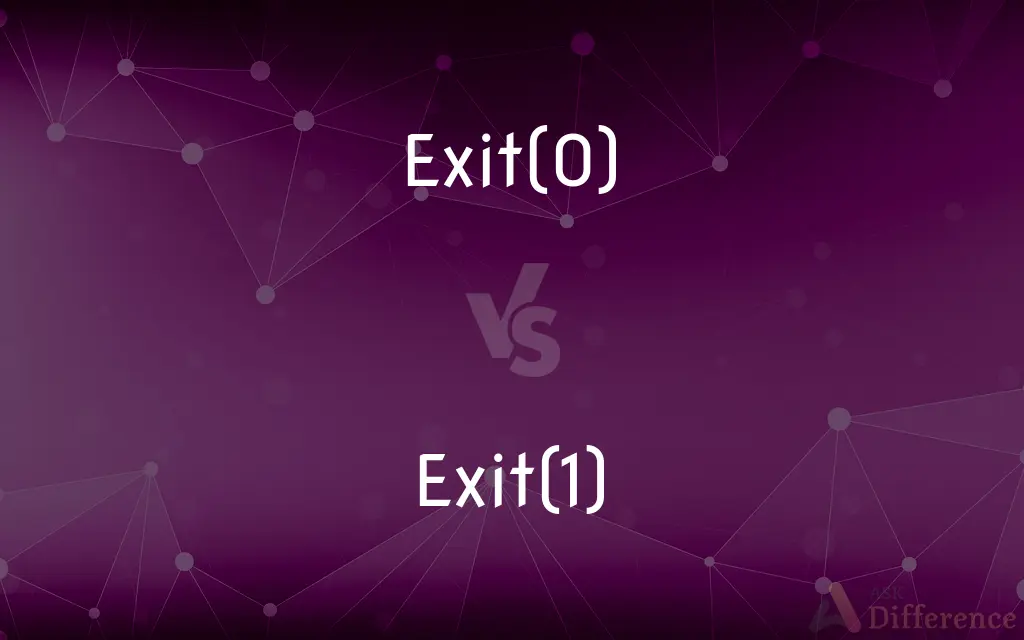Exit(0) vs. Exit(1) — What's the Difference?
By Tayyaba Rehman — Published on January 2, 2024
Exit(0) indicates successful program termination, while Exit(1) signifies that the program has encountered an error or anomaly and is terminating abnormally.

Difference Between Exit(0) and Exit(1)
Table of Contents
ADVERTISEMENT
Key Differences
Exit(0) and Exit(1) are commands in many programming languages used to terminate a program. Exit(0) is conventionally used to signify that a program has completed its execution successfully without errors. On the other hand, Exit(1) is typically used to indicate that the program has encountered an error or an issue that prevented it from completing successfully.
When a program ends with Exit(0), it communicates to the operating system or calling process that everything worked as expected. This is often seen in programs where all tasks are completed without issues. Conversely, Exit(1) is used to signal that there was a problem or unexpected behavior in the program, prompting the need for debugging or error handling.
The choice between Exit(0) and Exit(1) is essential for error handling in scripts and automated tasks. Scripts often use the exit status of programs (0 or 1) to decide the next steps. If a program exits with Exit(0), the script may proceed with subsequent tasks, but if it exits with Exit(1), the script might stop or execute a different set of commands to handle the error.
In some contexts, Exit(1) can be replaced with other non-zero values to provide more specific error information. However, Exit(0) is universally recognized as a successful execution, making it a standard for indicating success in various environments.
The use of Exit(0) and Exit(1) is not just limited to success and error signaling; it also plays a role in resource management. Exiting a program with these commands ensures that resources like memory and file handles are properly released back to the system.
ADVERTISEMENT
Comparison Chart
Significance
Successful program completion
Program encountered an error
Common Usage
Normal program termination
Abnormal program termination
Impact on Scripts/Automation
Indicates success, continues execution
Indicates failure, may halt or trigger error handling
Resource Management
Ensures resources are released properly
Ensures resources are released, but flags an issue
Customizability
Usually fixed as zero for success
Can be replaced with other non-zero values for specific errors
Compare with Definitions
Exit(0)
Used in scripts to signal successful execution.
The installation script finished and returned Exit(0).
Exit(1)
Signals an abnormal or unsuccessful program termination.
Due to a network error, the script exited with Exit(1).
Exit(0)
Informs the operating system of a normal termination.
The application shut down gracefully, returning Exit(0).
Exit(1)
Exit(1) indicates that a program has terminated with an error.
If the file is not found, the program exits with Exit(1).
Exit(0)
Indicates that the program ran without any errors.
After completing the data backup, the script exits with Exit(0).
Exit(1)
Informs the operating system or a parent process of a failure.
The update process failed, triggering an Exit(1) signal.
Exit(0)
Exit(0) signifies successful completion of a program.
If the file is processed correctly, the program exits with Exit(0).
Exit(1)
Used in error handling routines in programming.
The program encountered an exception and returned Exit(1).
Exit(0)
Commonly used in successful branches of conditional statements.
If all tests pass, the testing framework exits with Exit(0).
Exit(1)
Often used in conditional statements to handle exceptions.
If the user input is invalid, the application exits with Exit(1).
Common Curiosities
Is Exit(0) the only way to signal successful execution?
Yes, Exit(0) is the standard way to signal successful execution.
How do operating systems interpret Exit(0) and Exit(1)?
Exit(0) is interpreted as successful completion, while Exit(1) is interpreted as an error.
When should I use Exit(1) in my code?
Use Exit(1) to indicate an error or abnormal termination of your program.
Are Exit(0) and Exit(1) specific to a particular programming language?
No, they are used across various programming languages.
What happens if I don’t use an exit code in my program?
The program may return the default exit code, which is usually Exit(0) for successful completion.
What does Exit(0) mean in programming?
It means the program ended successfully without any errors.
Can I use different numbers other than 1 to indicate specific errors?
Yes, you can use different non-zero numbers to indicate specific error types.
Can Exit(1) be used to release system resources properly?
Yes, it exits the program and should release resources, but it also indicates an error.
Is it necessary to use Exit(0) in every program?
It's good practice but not always necessary; some languages assume Exit(0) by default at the end of a program.
In batch scripting, how are Exit(0) and Exit(1) used?
They are used to control the flow of execution based on success or failure.
Do Exit(0) and Exit(1) have the same effect in all environments?
Generally, yes, but some environments might handle exit codes differently.
Can Exit(1) be used for debugging purposes?
Yes, it can be used to indicate points of failure in your program for debugging.
Are there best practices for using Exit(0) and Exit(1) in software development?
Yes, use Exit(0) for success and Exit(1) or other non-zero values for specific error types, ensuring clarity in your program's execution flow.
In the context of CI/CD pipelines, how important are these exit codes?
They are crucial for determining the success or failure of build steps and scripts.
Do all programming languages support Exit(0) and Exit(1)?
Most programming languages support these exit codes or similar mechanisms.
Share Your Discovery

Previous Comparison
Simple Pendulum vs. Compound Pendulum
Next Comparison
Chelating Agent vs. Sequestering AgentAuthor Spotlight
Written by
Tayyaba RehmanTayyaba Rehman is a distinguished writer, currently serving as a primary contributor to askdifference.com. As a researcher in semantics and etymology, Tayyaba's passion for the complexity of languages and their distinctions has found a perfect home on the platform. Tayyaba delves into the intricacies of language, distinguishing between commonly confused words and phrases, thereby providing clarity for readers worldwide.
















































